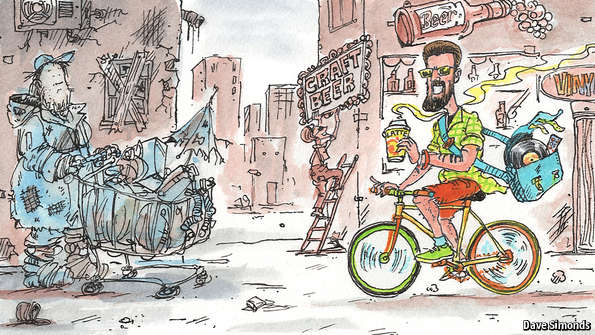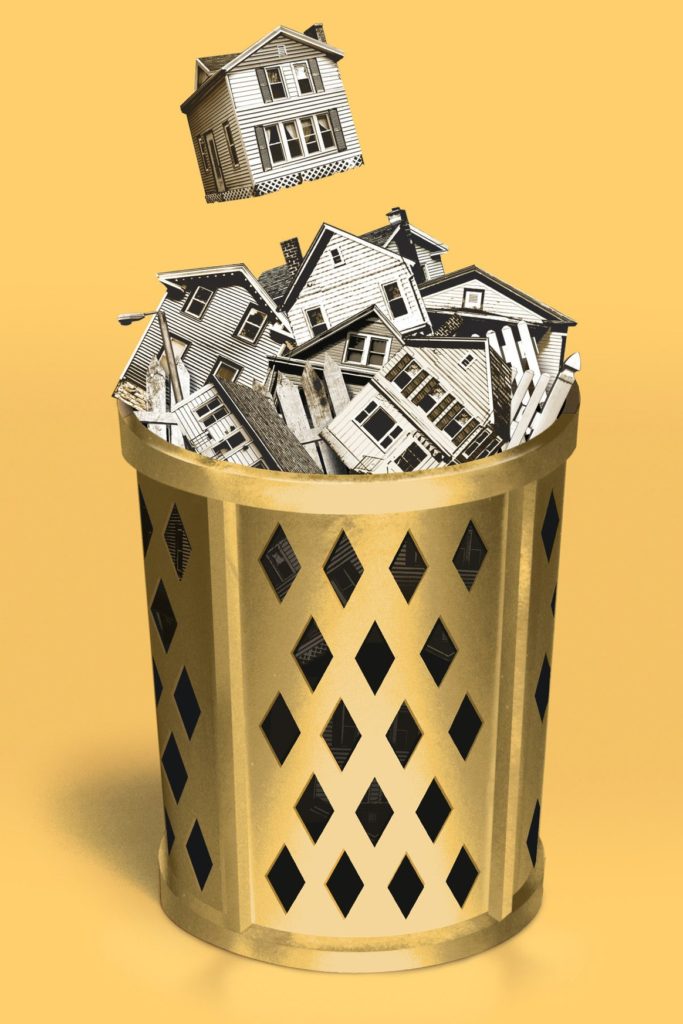IN 2013 PROTESTS broke out in Oakland, California, directed against the private buses that shuttle tech workers from pricey homes in the city’s gentrifying areas to jobs in Silicon Valley. “You live your comfortable lives,” read a flyer that protesters handed out to passengers, “surrounded by poverty, homelessness, and death, seemingly oblivious to everything around you, lost in the big bucks and success.”
That moment of backlash was an outgrowth of what I call the New Urban Crisis: the decline of middle-class neighborhoods, the gentrification of the downtowns of certain cities, and the reshaping of America’s metropolitan regions into islands of advantage surrounded by larger swaths of disadvantage.
Technology is one of the country’s biggest growth industries, but it comes at a price—just ask any teacher looking for housing in San Francisco. Meanwhile, other areas aspire to build similar tech-based economies, hoping to become a Silicon Alley, Prairie, or Gulch, though potentially triggering crises of their own. But it’s possible for these up-and-comers to succeed and for the red-hot San Franciscos to become less unequal and more affordable.
San Francisco is a case study in winner-take-all urbanism, in which the gains from knowledge capitalism flow to a select group of cities and to an even more select group of neighborhoods within them. After all, San Francisco is certainly attractive. It has the diversity, creative energy, street life, and openness to new ideas that entrepreneurs thrive on. But the same clustering that powers innovation and economic growth in the Bay Area also divides its people: Tech workers do well financially and bid up housing prices, which takes a toll on everyone else, especially blue-collar and service workers, who are increasingly priced out.
From our partners:
[infobox]Technology is one of the country’s biggest growth industries, but it comes at a price—just ask any teacher looking for housing in San Francisco.[/infobox]
Indeed, the New Urban Crisis is bound up with the recent shift in tech startups to cities. For most of its history, tech was located far outside cities, in generic “Nerdistans” like the suburban office campuses south of San Francisco. Today, however (shuttle buses notwithstanding), San Francisco is the world’s number one destination for venture capital: Two downtown neighborhoods each attracted more than $1 billion in VC funding in 2013—more than most other nations.
Some tech leaders say the problem will fix itself as the soaring cost of living in the Bay Area eventually pushes startups to less expensive places like Austin or Omaha. But the Bay Area’s share of startups and VC investment has increased from roughly 22 percent of the US total in 1995 to 46.5 percent in 2015.
The Bay Area can’t just wait to see what happens; it needs to overcome paralyzing NIMBYism and liberalize land-use restrictions to build more housing now. But expensive places also require investment in infrastructure: High-speed transit could do more to improve housing affordability than just about anything else, by allowing more workers to commute from outlying areas. New York’s extensive transit system is why it is becoming cheaper to live near Manhattan than it is to live near San Francisco.
Many aspiring tech hubs, like Pittsburgh, don’t have such divisive challenges—yet. But they need to be strategic about how they grow. They already have affordable housing, so what they have to focus on is building up their tech industries and startup ecosystems. As the most successful of these places have discovered, the key is to figure out exactly what they can foster and support. Some do this by working with local universities to leverage the science and tech being developed in their labs. Pittsburgh did not resurrect its steel industry; it tapped into Carnegie Mellon’s robotics expertise to establish a fertile environment for companies working on self-driving cars. Other cities can find their own niches. Nashville built an economy around music by first developing its country scene and then expanding into genres like Christian, pop, and rock.
San Francisco and Pittsburgh alike need to confront the collapse of the middle class. Manufacturing jobs aren’t coming back, and we can’t educate huge numbers of Americans for knowledge jobs. Instead, we must turn the nearly 60 million low-wage service jobs in food preparation, retail, and childcare into higher-wage, family-supporting jobs. This is analogous to what we did during the New Deal, when we turned low-wage factory jobs into high-paid middle-class jobs. If we were willing to pay a little more for our cars and appliances to create a middle class in the last century, surely we can afford to pay more in this one to the people who serve us food and care for our kids and aging parents.
One thing is certain: With Donald Trump in the White House and Republicans in control of both houses of Congress, the federal government won’t come to the rescue. The solution will have to come from local government, local industry, local universities, and local people working to move beyond winner-take-all urbanism and to a more sustainable and inclusive model of development that benefits everyone.
This essay is written by Richard Florida, director of cities at the University of Toronto’s Martin Prosperity Institute, adapted from his book The New Urban Crisis, recently published by Basic Books.














